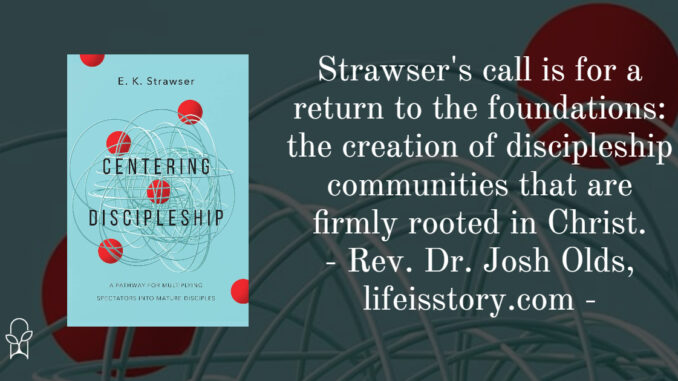
Published by IVP Genres: Non-Fiction, Christian Life
Buy on Amazon
Goodreads

Discipleship without mission is discipleship without Christ. The church often lacks maturity and missional impact because discipleship is at its periphery. In order to get discipleship to the center, leaders need a locally rooted, culturally contextual discipleship pathway to tether disciples who are disciplemakers to the neighborhood or network around them. Pastor and discipler E. K. Strawser shows that when discipleship becomes central to your leadership and community, then discipleship becomes central to congregational mission and cultural renewal. Centering Discipleship is a gutsy practice-based guidebook for leaders who are doing the hard work of re-imagining and re-structuring their churches and communities to turn spectators into missional, mature followers of Jesus.
In seminary, there was this saying that 10% of the people do 90% of the work. In reality, that might be closed to 5/95. Now, volunteering and doing the work necessary to keep a church functioning isn’t necessarily discipleship, but it does help illustrate the point that churches are not necessarily turning spectators into mature disciples. There’s been a huge on evangelism (and rightfully so), but what do we do once they’re in the pew? Do they just sit there and (so long as they tithe) just sort of hang out until they die?
Centering Discipleship, by EK Strawser, addresses this dearth of discipleship in the church and builds a practical blueprint for transforming churches into communities and building disciples. In the first part of the book, Strawser argues for the necessity of making discipleship central to the life of the church. She characterizes the goal of discipleship as maturity in Christ that is characterized by an individual’s character, theological formation, wisdom, and missional living.
The second part of the book builds a discipleship pathway designed to connect disciples, who are also disciplemakers, to their neighborhoods or networks. Strawser arranges the book as a practice-based guide, advocating for a shift from merely observing Christian practices to actively engaging in them. On one hand, everything she writes sounds self-evident and obvious. There’s nothing in Centering Discipleship that seems radical or surprising. But when I look at a lot of churches, her commonsense suggestions seem untested.
The final two parts of the book address the assumptions of discipleship and actually implementing a discipleship strategy. Here’s where the book takes off. I don’t think the problem is that churches want to lack in discipleship training or that they don’t know how to make disciples. It’s that it’s hard. The buy-in required for a spectator is for them to attend maybe two Sundays a month, two hours in total. The buy-in required for a disciple is “take up your cross and follow me.” It’s a lot harder. Moving people from passive spectators to active disciples is the hard part. Centering Discipleship gives readers the tools and the encouragement to persevere in creating disciples.
Overall, Centering Discipleship isn’t groundbreaking—but it isn’t groundbreaking because it’s foundational. Strawser’s call is for a return to the foundations: the creation of discipleship communities that are deeply rooted in Christ and on mission for the Kingdom of God. She accomplishes that with clarity and precision, making this book an excellent addition to the literature on discipleship.
